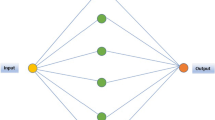Abstract
A method is presented to solve partial differential equations (pde's) and its boundary and/or initial conditions by using neural networks. It uses the fact that multiple input, single output, single hidden layer feedforward networks with a linear output layer with no bias are capable of arbitrarily well approximating arbitrary functions and its derivatives, which is proven by a number of authors and well known in literature. Knowledge about the pde and its boundary and/or initial conditions is incorporated into the structures and the training sets of several neural networks. In this way we obtain networks of which some are specifically structured. To find the solution of the pde and its boundary and/or initial conditions we have to train all obtained networks simultaneously. Therefore we use an evolutionary algorithm to train the networks. We demonstrate the working of our method by applying it to two problems.
Similar content being viewed by others
References
Attali, J-G. and Pages, G.: Approximations of functions by a multilayer perceptron: a new approach, Neural Networks 10(6) (1997), 1069–1081.
Bishop, C. M.: Neural networks for pattern recognition, Clarendon Press, Oxford, 1995.
Boyce, W. E. and DiPrima, R. C.: Elementary differential equations and boundary value problems, Fifth edition, John Wiley & Sons, Inc., New York, 1992.
Bruggeman, G. A.: Analytical solutions of geohydrological problems, Elsevier Science B.V., Amsterdam, 1999.
Demuth, H. and Beale, M.: Neural network toolbox for use with matlab, User's guide version 3, The MathWorks, Inc., Natick MA, 1998.
Gallant, R. A. and White, H.: On learning the derivatives of an unknown mapping with multilayer feedforward networks, Neural Networks 5 (1992), 129–138.
Houck, C. R., Joines, J. A. and Kay, M. G.: A genetic algorithm for function optimization: A matlab implementation, Technical Report NCSU-IE TR 95-09, North Carolina State University, Raleigh NC, 1995.
Hornik, K., Stinchcombe, M. and White, H.: Universal approximation of an unknown mapping and its derivatives using multilayer feedforward networks, Neural Networks 3 (1990), 551–560.
Li, X.: Simultaneous approximations of multivariate functions and their derivatives by neural networks with one hidden layer, Neurocomputing 12 (1996), 327–343.
Pohlheim, H.: Documentation for genetic and evolutionary algorithm toolbox for use with matlab (GEATbx): version 1.92, http://www.geatbx.com, 1999.
Ridder, D. de: Shared weights neural networks in image analysis, Master Thesis, Delft University of Technology, Delft, 1996.
Van den Boogaard, H. F. P. and Kruisbrink, A. C. H.: Hybrid modelling by integrating neural networks and numerical models, in Muller (ed.), Hydroinformatics' 96, pp. 471–477, Balkema, Rotterdam, 1996.
Yao, X.: Evolving artificial neural networks, Proceedings of the IEEE 87(9) (1999), 1423–1447.
Author information
Authors and Affiliations
Corresponding author
Rights and permissions
About this article
Cite this article
Aarts, L.P., van der Veer, P. Neural Network Method for Solving Partial Differential Equations. Neural Processing Letters 14, 261–271 (2001). https://doi.org/10.1023/A:1012784129883
Issue Date:
DOI: https://doi.org/10.1023/A:1012784129883




